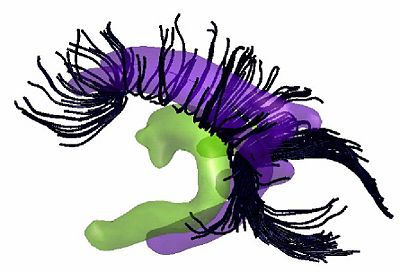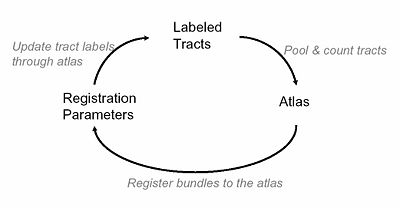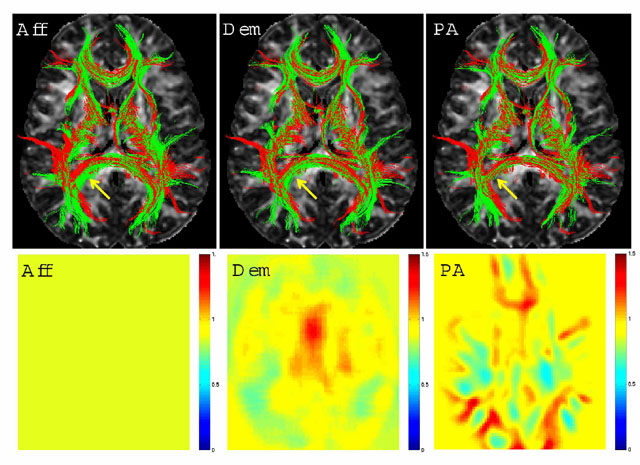Projects:DTIFiberRegistration
Back to NA-MIC Collaborations, MIT Algorithms
Joint Registration and Segmentation of DWI Fiber Tractography
The purpose of this work is to jointly register and cluster DWI fiber tracts obtained from a group of subjects. We formulate a maximum likelihood problem which the proposed method solves using a generalized Expectation Maximization (EM) framework. Additionally, the algorithm employs an outlier rejection and denoising strategy to produce sharp probabilistic maps (an atlas) of certain bundles of interest. This atlas is potentially useful for making diffusion measurements in a common coordinate system to identify pathology related changes or developmental trends.
Description
Initial Registration
A spatial normalization is necessary to obtain a group-wise clustering of the resulting fibers. This initial normalization is performed on the Fractional Anisotropy (FA) images generated for each subject. This initial normalization aims to remove gross differences across subjects due to global head size and orientation. It is thus limited to a 9 parameter affine transformation that accounts for scaling, rotation and translation. The resulting transformations are then applied to each of the computed fibers to map them into a common coordinate frame for clustering.
Initial Fiber Clustering
Organization of tract fibers into bundles, in the entire white matter, reveals anatomical connections such as the corpus callosum and corona radiata. By clustering fibers from multiple subjects into bundles, these common white matter structures can be discovered in an automatic way, and the bundle models can be saved with expert anatomical labels to form an atlas. In this work, we take advantage of automatically segmented tractography that has been labeled (as bundles) with such an atlas for initialization.
Joint Registration and Segmentation
Once we obtain an initial affine registration and clustering results using the high dimensional atlas, we iteratively fine-tune the registration and clustering results using a maximum likelihood framework, which is solved through a generalized EM algorithm. For the registration we use one set of affine parameters per fiber bundle, and combine these affine registrations into a single smooth and invertable warp field using a log-Euclidian poly-affine framework. Additionally, the algorithm employs an outlier rejection and denoising strategy while producing sharp probabilistic maps of certain bundles of interest.
We tested the registration component of this algorithm without updating the clustering with 26 major fiber bundles. The poly-affine warp fields with relatively limited number of components resulted in similar quality registrations when compared with results from a benchmark non-linear registration algorithm that was run on FA images:
Corpus Callosum, Cingulum and the Fornix were selected for further investigation because of the specific challenges they present. These three structures are in close proximity with each other, and that results in many mislabeled fibers when labeled using a high dimensional atlas (see figure below (left)). Their close proximity also results in a number of trajectories deviating from one structure to another. These are precisely the sorts of artifacts we wish to reduce through learning common spatial distributions of fiber bundles from a group of subjects.
We also constructed two different atlases to compare the effects of labeling algorithms on the quality of resulting group maps. The first one is constructed using the initial labels from the high dimensional atlas. A second one is built using the proposed algorithm:

Project Status
- Working 3D implementation in Matlab and C.
Key Investigators
- MIT: Ulas Ziyan, Mert R. Sabuncu
- Harvard DBP1: Carl-Fredrik Westin, Lauren O'Donnell
Publications
In Print



